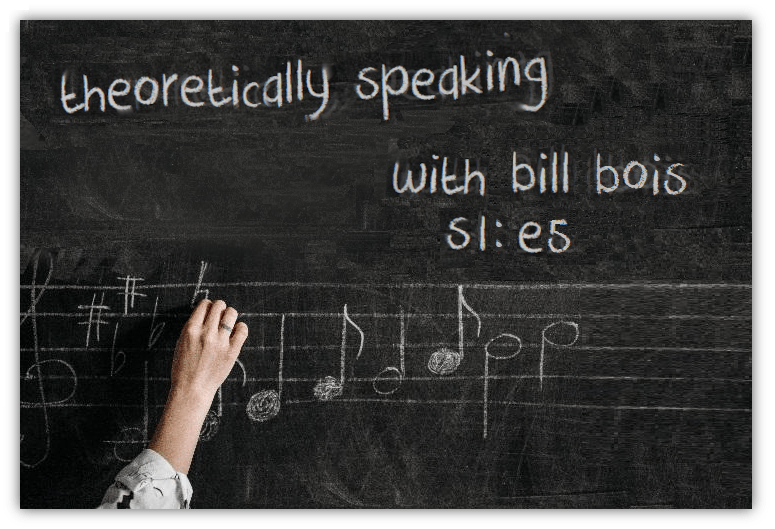Music Theory For Non-Musicians
…if there was ever an art where breaking the rules is one of the rules, it’s music.
This occasional series is about how music is made, and it’s for people who don’t already make music. It’s part music appreciation and part music theory.
I hope to cover rhythm, melody, intervals, chords, inversions, and more. Maybe we’ll get into extended chords and modes. Let’s see!
S1 : E5: Happy Together
Sometimes when people really don’t care about something, they’ll say, “I could care less.” What they mean, of course, is, “I couldn’t care less.” It’s such a common mistake that many people don’t consider it a mistake anymore. If you’re in the middle of a conversation with someone who says “I could care less,” you won’t stop and correct them. You’ll understand what they mean based on the context of the sentence, and let it slide.
Likewise, musicians sometimes use “tonic” and “root” interchangeably, but they’re not really the same thing. In our previous installment, S1:E4, we learned that the tonic is the first note in the scale. For the key of G Major, the tonic is G. When we’re using Bb minor, it’s Bb.
The tonic is sometimes referred to as the root, but that’s slightly incorrect. The words may stand in for each other, but the tonic is the first note of the scale. The root is the base note of a chord.
That’s base, not bass, though they’re usually the same.
Anyway, chords are what you get when you play two or more notes at the same time. Some combinations of notes sound great together.
Others, not so much.
Some chords have only two notes, and the most common two are the root and the 5th. The 5th is halfway between the root and its octave. Remember we talked about how each pitch has its own wavelength, and how the wavelengths have their own frequencies, and the frequencies interact with each other? The frequency of the 5th interacts with the frequencies of the root very well.
It’s a powerful sound. In rock, we call this a power chord. In other genres, it would be called a 5 chord, like C5. It’s neither major nor minor. We’ll get to major and minor momentarily.
Some bands use nothing but power chords. The guitarist in my punk band Psycho knew two variations of the power chord. One was the root and the 5th above it. The other was the root and the 5th below it. He’d move those two shapes around the neck of the guitar and, presto, guitar hero. He didn’t know any other chords, but it hasn’t slowed him down. He’s still making records 40 years later.
Chords with three notes are called triads. When we talk about triads, we usually mean three notes with a specific relationship with each other. There’s the root note, the 3rd, and the 5th.
This part can be confusing at first. We don’t mean the tonic and the 3rd and 5th of the scale. We mean the root note of the chord, the note two up the scale from the root, and the note two more notes up from there. To put it another way, consider the root to be the 1st, and add the 3rd and 5th notes up the scale from it.
You probably remember that the notes in the C Major scale are C, D, E, F, G, A, B, and then starting over again at C. So if the root note of our triad is C, we’d go up the scale two notes to the E, and then two notes from the E to the G. The C major chord then is C, E, and G.
I picked the C, E, and G in the middle of this diagram, but keep in mind it can be any C, E, and G across the keyboard. It just depends on whether you want high notes or low notes.
If we’re still in C Major, which means we’re sticking to the white keys, but the root note of the chord is F, we’d go up two notes to the A and up to more notes to the C. The notes of the F major chord are therefore F, A, and C. Make sense?
While we’re at it, let’s do G. The root is G, the next note is up two so it’s a B, and then two more to D. G, B, and D make G major.
I picked C, F, and G because they’re the three major chords in the key of C Major. What makes them major chords?
The difference between a major chord and its minor chord is the 3rd. If you take, for example, the G major chord with its notes of G, B, and D, and then flatten the 3rd so you now have G, Bb, and D, you now have the G minor triad.
Let’s count this out in half steps and whole steps. For a major chord, start from the root and go up two whole steps to the 3rd. For a minor chord, go up a whole step and a half step. Two whole steps up from a G is B. A whole step and a half step from G is Bb.
The 5th is the same in both major and minor chords.
So that’s three chords we know in the key of C Major. What about the others?
Let’s see what the D chord will be. We’ll start with the D, of course and, again sticking to the white keys, go two notes up the scale, which will be an F, and two more notes up from there, which will be an A. So the question is, is this D major or D minor?
Well, let’s count the steps from the root to the 3rd. D to E is a whole step, and E to F is a half step. When the interval from the root to the 3rd is a whole step and a half step, it’s a minor chord. It’s D minor.
To get a D major, we’d have to go up two whole steps. That would put us on the F#, which isn’t in the key of C Major so we use the F instead. (We don’t go up to the G because that’s the 4th of the scale. We’ll use the flattened 3rd instead.)
Likewise the E chord in the key of C Major would have to use G, so it’s E minor. And the A chord would have to use the C, so it’s C minor.
So far, that gives us C major, D minor, E minor, F major, G major, and A minor. What kind of chord will have B as its root in the key of C Major?
It’s complicated. We have to stick to the white keys in C Major, so let’s go up two notes from the B. It’s the D, which is a whole step and a half step up. That suggests it’s a B minor, but let’s keep going.
Remember that the 5th in both major and minor chords is up a total of three whole steps and a half step. If we were to do that starting on the B we’d get the F#, which isn’t in the key of C Major. We’ll have to flatten it and use the F. That makes the chord’s notes B, D, and F.
Chords with a flattened 3rd and a flattened 5th are called diminished chords, so this is a B diminished. We can call it a B dim, for short.
Some people say there’s only one other type of triad. It’s called the augmented chord and it uses the root and the major 3rd, and it sharpens the 5th. A C augmented, or C aug, would therefore use the notes C, E, and G#. (This one obviously isn’t in the key of C Major.)
Other people say suspended chords or any chord with three notes is a triad. It’s complicated and not really worth arguing about. We’ll get to these chords down the road..
So, to go back to the start of this article, every note in a scale can be the root of a chord within that scale, but the scale itself can only have one tonic. You know that, and I know that, but people will still use “tonic” when they mean “root” and vice versa. Now that you know the difference, however, you can let it slide. You could care less.
That’s enough for one day, but let’s look ahead to some questions we can ask:
• Do chords always have to be played with the 1st on the bottom?
• Can chords have more than three notes?
• What’s for lunch?
I can’t answer all your questions, but I’ll try. Just ask below.
Let the author know that you liked their article with a “heart” upvote!





Great post, Bill.
Can chords have more than 3 notes? Something tells me: yes. 🙂
I will leave it to you to explain to our wonderful community.
What, and spoil the season finale?
“Finale” ???
Oh, no… 🙁
Man, I’m going to have to dive into this and re-read it to gain a better understanding…but I do have one question:
Is a chord limited to the notes within the same octave? Could someone choose a C/E/G from a different eight notes as the other two? Is this impossible to play on a single instrument? Is this accomplished by using multiple instruments?
Multiple instruments or a piano player with really big hands. 🙂
When you think of all the instruments of a full orchestra playing at the same time, the low notes of the double basses will be nowhere near any note the flute plays. So in the unlikely event that every instrument is playing a C, They’re going to be in all sorts of different octaves.
But to stick with the piano, the player could play a very low C with his left hand and a very high E and G with his right, and it would still be a C major.
Great stuff. Very helpful, as always.
Although I still B dim, I C Major progress up ahead.
That’s a good joke for our Canadian friends, A?
Okay, I’ve got a crazy idea for you… Here’s your ticket to millions…
Circle of fifths pitch pipe!
Yes, it’s a pitch pipe but in circle of 5ths order instead of sequential order. And it’s circular!
Surely there are still people who still tune their instruments old school, right?
I get 10% of the profits BB. 😜
And if we’re really clever, we can design it so it does the Circle Of 4ths, too! We’ll make a fortune!
Sorry folks. Musician jokes.
Inverted 🤯
VDOG!!!!
Nom-nom-nom
I enjoyed this chapter especially, a lot to chew on with this entry. Thank you for putting the time and effort into explaining all of that so effectively!
PS – mt, does that lunch consist of free range sea bass, or ill tempered ones with frickin laser beams on their heads??
I was going to check with our official tnocs.com Master Chef, but I just realized: we don’t have one.
I’ll ask HR to write up a requisition. Any volunteers?
Does a guy like Kevin Parker abandon the guitar because, hypothetically(as if I know the guy; I once tried to tame a mongoose; it can’t be done), every time he sat down to write a song, his selected chords would remind him of hundreds upon hundreds of other songs?
Hypothetically, no. W. H. Davenport Adams said “That great poets imitate and improve, whereas small ones steal and spoil.” If that’s so, then if Parker did find himself playing, say, “Nice & Slow,” he’d ask himself what if he changed a chord from minor to major and another from a 7 to a sus 4. He’d “imitate and improve.”
Or maybe he’d do a cover version. Hmmm…..
I always wondered what a power chord is! But I think I’m missing a nuance – if a power chord is just the root and 5th, how does that work on guitar? Aren’t most guitar chords 6 notes? Also, it looks like I came to late for lunch; are there any leftovers?
Yes, there are six strings, but you don’t have to play all of them at the same time. Some chords do indeed use all six strings. Some use five or four or three or, yes, two.
Full disclosure, most power chords are actually, the root, the 5th, and the octave of the root. So it uses three strings. It’s an easy shape to play and really powerful.
That first power chord of The Who’s “Won’t Get Fooled Again” is an A power chord that’s actually A, E, A an octave up, E an octave up, and A two octaves up. That’s why it’ll blow your hair back.
This is awesome stuff. I may never play an instrument, but I’m slowly starting to understand how this stuff works. I mentioned a couple weeks back that I’m hooked on reaction videos; well, I also love watching the videos where Rick Beato breaks down what makes certain songs great (literally breaks them down into isolated instrumentation tracks…that kind of shit fascinates me to no end). Your master class here is a Major help with actually knowing the chords and notes he’s talking about.
I love that series, too. Hearing the isolated drums or vocals or whatever is fascinating. There’s always so much more going on than you think and it’s not until you hear the individual parts that you truly understand the whole.